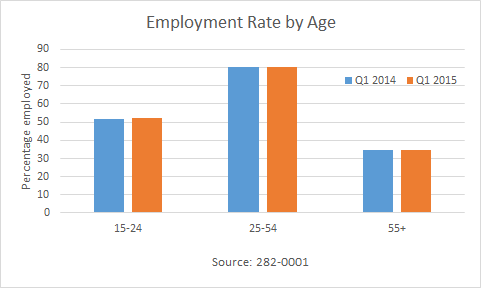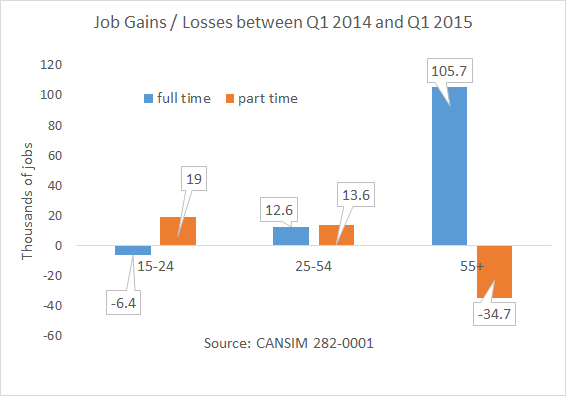Jobs Gains Skew Part-time, Over 55
The Canadian labour market added 29,000 jobs in March, beating expectations. Underneath the headline, though, the numbers aren’t as rosy.
A jump of 57,000 part-time jobs masked the loss of 28,000 full-time jobs between February and March.
Given the jumpy nature of monthly LFS data, I’ve decided to base most of my analysis on quarterly numbers. And since most of the job gains were in the 55+ age group, I thought it would be interesting to look at the FT / PT breakdown by age.
Using seasonally unadjusted data, I compared Q1 2014 with Q1 2015. We find that part time jobs dominate in the under 55 age group, and full-time jobs dominate in the over 55 age group. Since more boomers age into that category every day (and will be doing so for the next few years still) the meaning of that is questionable.
In fact, what we see when we look at employment rates, is that they haven’t budged for any age category. So employment growth in all age groups has only just kept pace with population growth, and not made a dent in our stagnant labour market.

Over the medium term though, we have seen an increase in the employment rate of 55+, and a decrease in the employment rate of 15-24 year olds. Using seasonally adjusted data, there has been a steady increase in the employment rate of workers over 55, with nary a blip for the recession.
On the other hand, the employment rate for young workers 15-24 fell 5 percentage points during the recession, and remains 3 percentage point lower than in Q1 2007.
Take away – there’s a stagnant job market for core age workers, and an awful one for young workers.
What we don’t need is more of the same economic mismanagement, focused on cuts rather than opportunities for growth. We need to build a sustainable economy for the future.



Also, if the overall job growth represents an overall loss of full-time jobs masked by a greater gain in part-time jobs, and if the total gain in jobs is barely enough to maintain exactly the same overall employment rate, presumably the rate of full-time employment is dropping significantly–especially since this is a pattern I seem to see every time someone talks about job growth.
How much has the full-time employment rate dropped over the last couple of years? How much has it dropped for young workers? It would seem they’re getting hosed doubly–they’re losing total jobs, and on top of that they’re massively losing full time jobs so that the few jobs they have left are mostly crap.
Letter in National Post
http://news.nationalpost.com/full-comment/todays-letters-canadas-best-kept-secret
State’s responsibility
Re: Are The Tories Good ‘Economic Managers’?, Stephen Gordon, April 7.
Economics, in a democracy, must serve public purpose. That means citizens have access to income. Although Canada has a mature welfare system, most able-bodied people rely on employment to pay their bills. Public purpose requires government to assure sufficient jobs are available even when the private sector cannot provide them.
That the government has the power to create jobs is proven by the experience of the Second World War when one in three adult males was in military service and many civilians made munitions on government contract. The state’s immense wartime expenditure did not damage the economy, but on the contrary left it stronger with a well-disciplined workforce. As British politician Tony Benn exclaimed, “If you can have full employment by killing Germans, why can’t we have it by building hospitals, schools, recruiting nurses and teachers? If you can find money to kill people, you can find money to help people.â€
Stephen Gordon’s view economic competence is a meaningless term is a scathing indictment of orthodox economics, with its erroneous belief a positive outcome (full employment) is beyond the scope of human agency, and must be left to market whim.